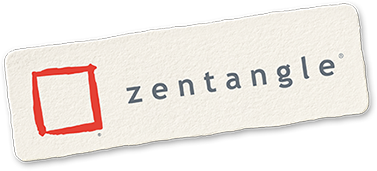In 2007, we started BLOG Zentangle and began our enjoyable series of conversations within our Zentangle community.
In reading through these blog posts with their insightful comments, we decided to bring a few of them to your attention from time to time. It is easy, for me anyway, to sometimes think of old information as stale information. But these insights and conversations are anything BUT stale!
In 2017, Rick writes...
Deconstruction: To reduce a pattern to its elemental strokes so that a user of the Zentangle Method can recreate it as a tangle by repeating those strokes one at a time in a simple, structured sequence.
Why is deconstruction important?
When you tangle a deconstructed tangle:
- The part of you that solves problems or criticizes takes a break.
- You enter a state of “flow” as you focus on each stroke, because
- You know you’ll know what to do later when the time comes, and since
- You’re not concerned about the outcome,
- You enjoy the process.
Inspirations for tangles are all around us. I saw this box in a museum:

It inspired the tangle well. **


As you become aware of patterns, you will also begin to see their structure and their “elemental strokes.”
In the Zentangle Method elemental strokes are a dot, a straight(ish) line, a curve, an “S” shape and an orb. With these elements, you can draw all our tangles. This is why we say, “If you can write your name, you can create Zentangle Art.
When you understand that all patterns are made of smaller elements, you look at patterns in art with a new perspective.
Complex patterns and designs become understandable as you discover their elemental strokes and structure . . . in other words, when you deconstruct it. And once you deconstruct it, you can tangle it. And once you can tangle it, you can express it in your own style.
Deconstruction Suggestions
- Keep it simple. Most of our tangles are made from one, two, or maybe (like well) three elemental strokes.
- Keep it non-representational.
If you think you’ve come up with a new tangle, send it to Linda Farmer, CZT, at www.tanglepatterns.com and she may post it on her site.*
NOTE: Creating a pattern and deconstructing a pattern are different. Many Zentangle tangles are deconstructed from pre-existing patterns. For instance, the pattern that inspired the tangle well was created centuries ago.
One More Suggestion
We say that the “Zentangle Method is a metaphor for life,” that “Life is an artform,” and that “Everyone is an artist.”
Patterns are everywhere . . . and not just the obvious ones you might associate with the Zentangle Method of drawing. For instance, there are patterns of behavior, personal interaction and social organization. You can also apply a Zentangle approach to those patterns.
What are their “elemental strokes”? How are they arranged? Can you deconstruct it? Can you “tangle” it? And even more fascinating, might discover a new “tangle” of behavior or interaction or organization for others to explore?
Remember, “Life is an artform” and “Everyone is an artist”!
Rick
--- + ---
* Tangle Patterns is a great resource, run by a CZT, but not affiliated with Zentangle, Inc.
* *More about well in this newsletter.



I have looked for Zentangle tutors in Qld Australia but only the names and cities come up. How do I contact anyone? I live in Bundaberg Qld Australia.
Thank you
Kind regards
Roslyn Hamilton
Roslyn Hamilton on
Sue Leslie on
Rimona Gale on
Bruno Kudrecki on
This is again a very inspiring blog. It encourages me to focus even more on deconstruct. Thank you for this reminder.
Irene Lammerse CZTeu1 on
When an”Tangle”or a “Zentangle” is very symmetrical I find it’s not as relaxing. I find it too structured for me. Whereas if they are less balanced I enjoy them more and find them much more relaxing and miserizing. It it just me or do others feel the same.
Buddy on
Since I started doing Zentangle I find myself always looking at the patterns around me…even one on my husbands tie! Thanks for the revisit…I enjoy these blogs immensely!
Dianne Riva Cambrin on
What does this mean, please?
—Keep it non-representational.
Enjoyed this blog very much. Enjoyed your beautiful Well.
Judy on
Great idea to “refresh” our memories of blogs past! I remember struggling with “Well” during my training, but this step out looks so easy, that I’m going to do it today! Thank you!
Jamie Herron, on
Thanks for the great reminder. We all need them! I, too, like Mary Lou, feel inspired today to revisit “Well” by creating a tile using it.
Paula Schneider on
Well, well, who, Whatthewell…
Lisa Hoesing on
Well, well, who, Whatthewell…
Lisa Hoesing on
Mary Lou Minard on
Thank you. This was beautiful and a great revisit to the fundamentals of deconstruction, which I call reuse, over and over again. ☮️
Miriam Zimms on